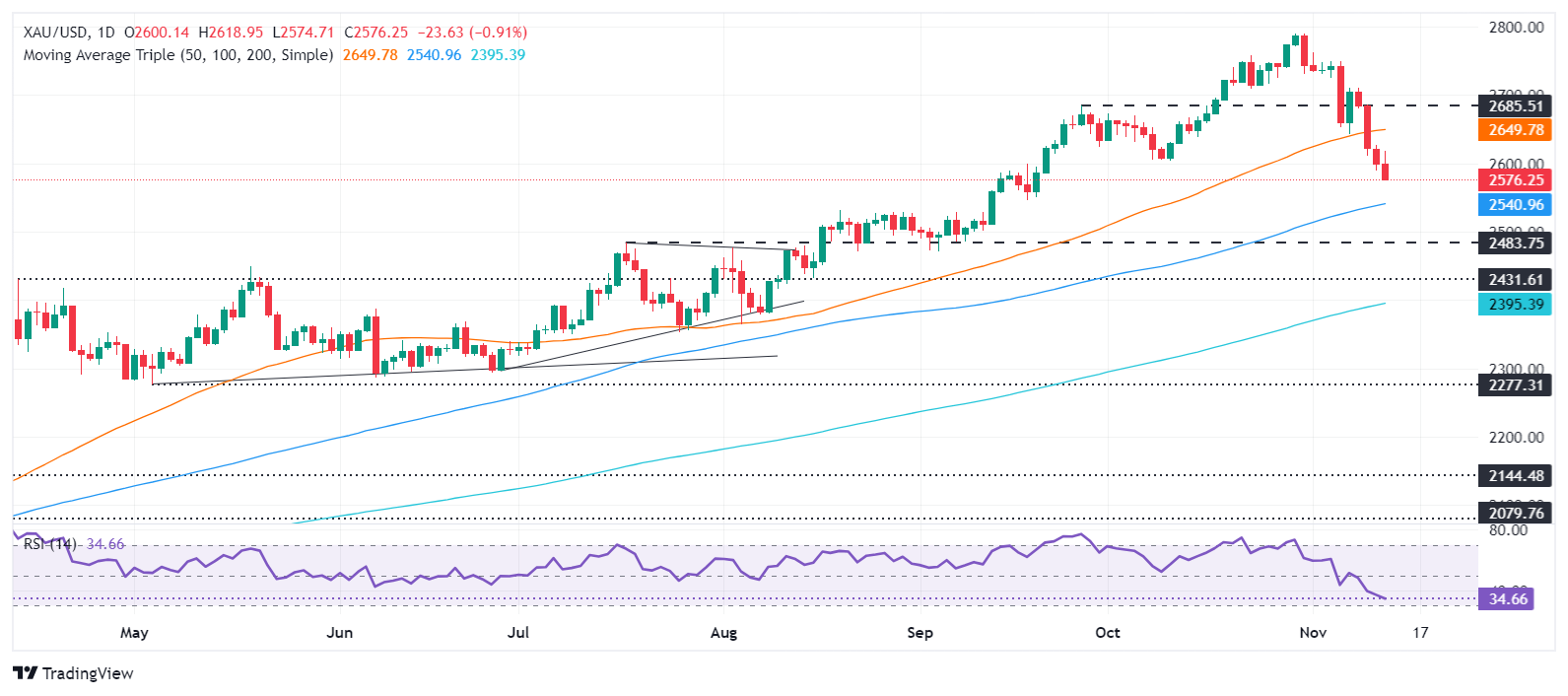- Gold retreats amid stable US inflation data, continuing a four-day losing streak.
- US Dollar Index reaches a year-to-date high of 106.52, buoyed by market expectations of less dovish Fed.
- Upcoming economic events, including Fed Chair Powell's speech and US Retail Sales, to further influence Gold's trajectory.
Gold's price tumbled on Wednesday following October’s inflation report, which was aligned with estimates. The yellow metal hit a daily peak of $2,618 but retreated as US Treasury yields climbed, and the Greenback extended its gains to a new year-to-date (YTD) high, according to the US Dollar Index (DXY). The XAU/USD trades at $2,581, losing more than 0.60%.
Bullion extended its losses for the fourth straight day after the US Bureau of Labor Statistics (BLS) revealed that headline and core inflation figures for October came in as Wall Street expected.
The buck printed solid gains, although market participants had almost entirely priced in 25 basis points by the Federal Reserve (Fed) at the December meeting. According to the CME FedWatch Tool data, odds rose from 58% a day ago to 82%.
The DXY, which tracks the performance of the US Dollar against a basket of peers, hit a YTD high of 106.52, surpassing the April 16 high of 106.51. As of writing, the DXY hovers around 106.49, gaining 0.50%.
US Treasury bond yields continued to rise with the 10-year benchmark note yielding 4.453%, two and a half basis points above its opening yield.
Market participants remain aware that Trump's presidency might dent the Fed from easing policy if inflation climbs due to low taxes and new tariffs.
Looking forward to this week, traders are eyeing Fed Chair Jerome Powell's speech. The US Producer Price Index (PPI) and jobs data are due on Thursday. On Friday, Retail Sales will update the status of American consumers.
Daily digest market movers: Gold remains pressured by a firm US Dollar
- Gold prices fell as US real yields, which inversely correlate against Bullion, edged up one basis point to 2.089%.
- The US CPI rose as anticipated to 2.6% YoY, up from 2.4%, with a 0.2% monthly increase as expected.
- Core CPI also aligned with forecasts, rising 3.3% annually and 0.3% on a monthly basis, matching private analyst projections.
- Minneapolis Fed President Neel Kashkari stated that the US central bank would need to lower borrowing costs, adding that inflation heads “in the right direction.”
- Echoing some of his comments was the Dallas Fed’s Lorie Logan, stating the US central bank “most likely” needs to reduce its restrictive policy, though it must proceed cautiously.
- St. Louis Fed’s Alberto Musalem said that although inflation data was stronger, it doesn’t change his view that policy is on path to neutral.
- Kansas City Fed Jeffrey Schmid was more cautious, saying “it remains to be seen” how much more the Fed will cut rates.
- According to the Chicago Board of Trade’s December fed funds rate futures, investors now anticipate approximately 23 basis points of Fed easing by the close of 2024.
XAU/USD Technical Outlook: Gold price tumbles below $2,600
The Gold price has shifted neutral to bearishly biased, once it cleared the October 10 swing low of $2,603. Once bears achieved a daily close below the latter, it opened the door to challenge the 100-day Simple Moving Average (SMA) at $2,540. On further weakness, the next support would be $2,500.
On the other hand, if Gold clings to $2,600, buyers will eye the 50-day SMA at $2,647, ahead of $2,650. Once surpassed, the next resistance would be the November 7 high at $2,710.
Momentum has shifted bearishly as the Relative Strength Index (RSI) distanced itself from its neutral line, indicating that XAU/USD might extend its losses.
Economic Indicator
Consumer Price Index (MoM)
Inflationary or deflationary tendencies are measured by periodically summing the prices of a basket of representative goods and services and presenting the data as The Consumer Price Index (CPI). CPI data is compiled on a monthly basis and released by the US Department of Labor Statistics. The MoM figure compares the prices of goods in the reference month to the previous month.The CPI is a key indicator to measure inflation and changes in purchasing trends. Generally, a high reading is seen as bullish for the US Dollar (USD), while a low reading is seen as bearish.
Read more.Last release: Wed Nov 13, 2024 13:30
Frequency: Monthly
Actual: 0.2%
Consensus: 0.2%
Previous: 0.2%
Source: US Bureau of Labor Statistics
The US Federal Reserve has a dual mandate of maintaining price stability and maximum employment. According to such mandate, inflation should be at around 2% YoY and has become the weakest pillar of the central bank’s directive ever since the world suffered a pandemic, which extends to these days. Price pressures keep rising amid supply-chain issues and bottlenecks, with the Consumer Price Index (CPI) hanging at multi-decade highs. The Fed has already taken measures to tame inflation and is expected to maintain an aggressive stance in the foreseeable future.
Information on these pages contains forward-looking statements that involve risks and uncertainties. Markets and instruments profiled on this page are for informational purposes only and should not in any way come across as a recommendation to buy or sell in these assets. You should do your own thorough research before making any investment decisions. FXStreet does not in any way guarantee that this information is free from mistakes, errors, or material misstatements. It also does not guarantee that this information is of a timely nature. Investing in Open Markets involves a great deal of risk, including the loss of all or a portion of your investment, as well as emotional distress. All risks, losses and costs associated with investing, including total loss of principal, are your responsibility. The views and opinions expressed in this article are those of the authors and do not necessarily reflect the official policy or position of FXStreet nor its advertisers. The author will not be held responsible for information that is found at the end of links posted on this page.
If not otherwise explicitly mentioned in the body of the article, at the time of writing, the author has no position in any stock mentioned in this article and no business relationship with any company mentioned. The author has not received compensation for writing this article, other than from FXStreet.
FXStreet and the author do not provide personalized recommendations. The author makes no representations as to the accuracy, completeness, or suitability of this information. FXStreet and the author will not be liable for any errors, omissions or any losses, injuries or damages arising from this information and its display or use. Errors and omissions excepted.
The author and FXStreet are not registered investment advisors and nothing in this article is intended to be investment advice.
Recommended content
Editors’ Picks

EUR/USD stabilizes near 1.0550, looks to post weekly gains
EUR/USD continues to fluctuate in a tight channel at around 1.0550 in the American session on Friday as trading action remains subdued with US financial markets heading into the weekend early. The pair looks to end the week in positive territory.

GBP/USD loses traction, retreats below 1.2700
After climbing to its highest level in over two weeks at 1.2750, GBP/USD reverses direction and declines to the 1.2700 area on Friday. In the absence of fundamental drivers, investors refrain from taking large positions. Nevertheless, the pair looks to snap an eight-week losing streak.

Gold pulls away from daily highs, holds near $2,650
Gold retreats from the daily high it set above $2,660 but manages to stay afloat in positive territory at around $2,650, with the benchmark 10-year US Treasury bond yield losing more than 1% on the day. Despite Friday's rebound, XAU/USD is set to register losses for the week.

Bitcoin attempts for the $100K mark
Bitcoin (BTC) price extends its recovery and nears the $100K mark on Friday after facing a healthy correction this week. Ethereum (ETH) and Ripple (XRP) closed above their key resistance levels, indicating a rally in the upcoming days.

Eurozone PMI sounds the alarm about growth once more
The composite PMI dropped from 50 to 48.1, once more stressing growth concerns for the eurozone. Hard data has actually come in better than expected recently – so ahead of the December meeting, the ECB has to figure out whether this is the PMI crying wolf or whether it should take this signal seriously. We think it’s the latter.

Best Forex Brokers with Low Spreads
VERIFIED Low spreads are crucial for reducing trading costs. Explore top Forex brokers offering competitive spreads and high leverage. Compare options for EUR/USD, GBP/USD, USD/JPY, and Gold.
